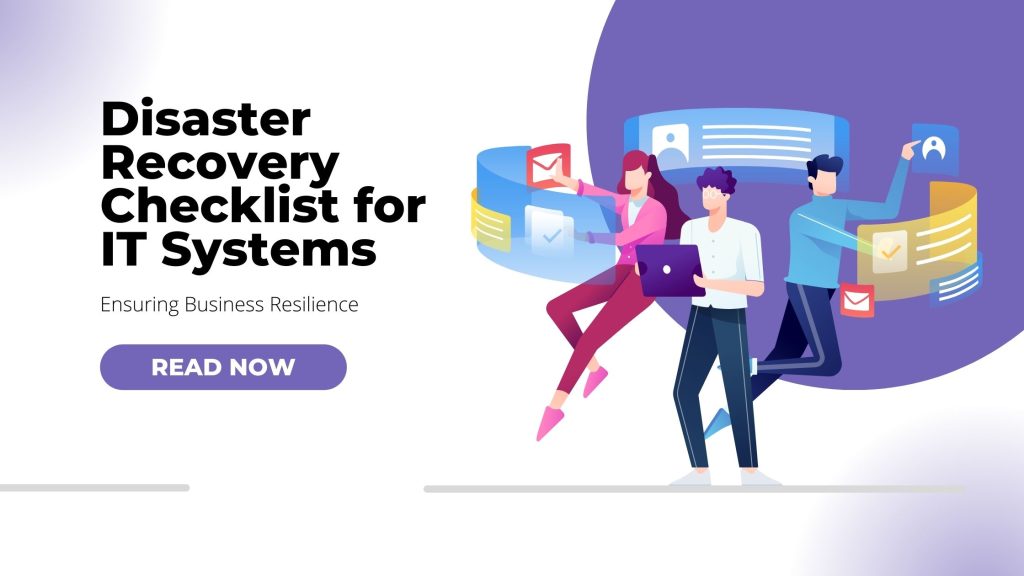Table of Contents
Disaster Recovery Checklist for IT Systems
The dependence on IT systems for corporate operations is apparent in today’s digital environment. Organizations must prioritize disaster recovery planning, nevertheless, due to the frequency and complexity of disruptive situations that are on the rise. To maintain business resilience and reduce downtime, an IT disaster recovery checklist that is well-defined and frequently updated is crucial. We will examine the essential components of a disaster recovery checklist in this extensive tutorial.

Disaster Recovery Checklist for IT Systems
- Risk Assessment and Business Impact Analysis (BIA):
Conduct a thorough risk assessment to identify potential threats and weaknesses as the first step in creating your disaster recovery checklist. Determine the potential impact these threats may have on your IT systems and rank the most important business processes in accordance. We stress how important it is to synchronize risk assessment and BIA with your overarching strategy.
- Documenting IT Systems and Dependencies:
An exhaustive list of all IT systems and their dependencies should be included in a disaster recovery checklist. A thorough overview of your IT ecosystem is ensured by documenting hardware, software, network infrastructure, and interdependencies. We emphasize its importance in creating a comprehensive image of the IT assets within your company.
- Defining Recovery Time Objectives (RTOs) and Recovery Point Objectives (RPOs):
Set recovery time objectives (RTOs) and recovery point objectives (RPOs) to define the acceptable time range for recovering crucial IT systems and data. Define the maximum acceptable downtime and data loss levels in detail, making sure they meet your company’s needs.
- Backup and Data Recovery:
Put in place a reliable backup plan and remember to include it in your disaster recovery checklist. Make sure to regularly back up all important data and store it off-site for further security. Define the process for restoring data as well as the backup frequency and retention time. We emphasize its significance in protecting data backups and aiding successful recovery.
- Disaster Recovery Team and Roles:
Create a team for disaster recovery with roles and duties that are well-defined. Designate essential employees who will carry out the recovery plan, and make sure they are accessible in times of need. We stress how important it is for establishing the team’s organizational structure and encouraging accountability.
- Communication and Incident Response:
During a disaster recovery scenario, effective communication is essential. Include communication methods and contact lists in your checklist to ensure prompt and accurate information transmission. Create an escalation process and contact points for an incident response structure.
- Regular Testing and Training:
Test your disaster recovery strategy frequently to find any holes or potential improvements. To assess the success of the restoration of your IT systems, run simulated recovery scenarios. Additionally, provide your team members thorough instruction on their responsibilities throughout recovery attempts.
- Documentation and Checklist Review:
Review and update your disaster recovery checklist frequently to account for adjustments to your IT infrastructure, systems, and business processes. Make careful to keep the rehabilitation plan current and to keep track of any changes. We emphasize its importance in preserving a precise and pertinent checklist.
SyncCore Cloud
An ideal solution to enhance your disaster recovery efforts for IT systems is SyncCore Cloud. SyncCore Cloud is a leading cloud service provider that offers a reliable and secure infrastructure for data backup, replication, and recovery. By incorporating SyncCore Cloud into your disaster recovery checklist for IT systems, you can benefit from its advanced features and comprehensive support.
Secure cloud storage options are offered by SyncCore Cloud, guaranteeing the security of your important data. To prevent unauthorized access or breaches, their data centers are outfitted with strong security features, such as encryption and access controls. Organizations may feel secure knowing that their data is in good hands by endorsing SyncCore Cloud.
With the high availability and redundancy features of SyncCore Cloud, you can set up failover methods and reduce downtime in the event of a disaster. Data replication and speedy recovery are made possible by their geographically dispersed data centers, assuring company continuity. You may improve your IT systems’ resilience and ensure continuous operations by utilizing SyncCore Cloud.
In order to make the recovery process simpler, SyncCore Cloud also provides disaster recovery as a service (DRaaS). Organizations can replicate their whole IT infrastructure on the resilient platform of SyncCore Cloud using DRaaS. This streamlines the recovery process and gets rid of the need for a lot of infrastructure on-site, saving time and money.
In addition, SyncCore Cloud offers thorough training and assistance to ensure businesses can use its services in the event of a crisis. The implementation and execution of your disaster recovery checklist for IT systems can be significantly improved by their knowledge and direction.
Finally, including SyncCore Cloud in your disaster recovery checklist for IT systems will considerably improve your capacity for preparation and response. DRaaS capabilities, high availability features, and secure cloud storage options make SyncCore Cloud a great option for businesses wishing to protect their IT infrastructure. You may easily navigate through disruptive occurrences and guarantee the continuity of your business operations by utilizing the services provided by SyncCore Cloud.
Read More:
Advantages of Cloud Services for E-commerce: Scaling Your Business with Cloud Technology in 2023



